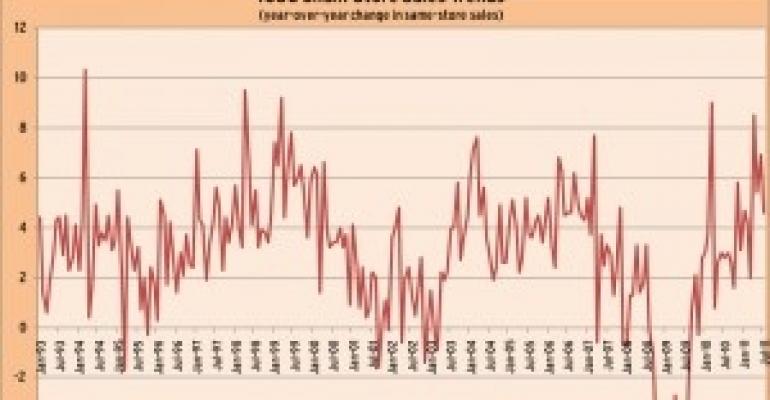July same-store sales rose by more than 4.0 percent year-over-year as retailers kicked off the back-to-school season. Most attributed the gains to discounts and the warmest July weather in many years.
Warehouse clubs Costco and BJ's and luxury chain Saks posted some of the biggest gains, highlighting the bifurcation in the consumer-driven U.S. economy. Department store and other retailers that cater to the middle were among those that disappointed."The folks that are doing well economically are going to continue to spend at a pretty good clip, and the families that have less means are going to continue to pick and choose and only spend on what they need versus what they want," said Alison Paul, leader of advisory firm Deloitte's U.S. retail practice.
The July figures made some chains, such as Target Corp, optimistic about demand heading into the back-to-school season, the second-biggest selling period of the year after Christmas.
"Back-to-school sales are off to a solid start, contributing to our confidence in the strategies we have in place and our ability to execute them," Target Chief Executive Officer Gregg Steinhafel said on Thursday.
Despite the numbers, as I've written in other monthly roundups, it's important that we remember that the pool of retailers that still report same-store sales numbers is considerably smaller than it once was. Less than 30 retailers use the metric (down from more than 70 a few years ago). Wal-Mart stores, which singlehandedly accounts for roughly 5 percent to 6 percent of the overall retail pie, only reports quarterly figures today. And it has reported comparable store sales declines (excluding fuel sales) for eight straight quarters.
Were they still in the monthly matrix, the figures would look quite a bit different.
My look inside the monthly reports is after the jump.
Thomson Reuters reported a 4.4 percent gain, ICSC estimated that sales rose 4.6 percent and Retail Sails and Kantar Retail both said the increase was 4.8 percent.
ICSC
ICSC's tally shows that same-store sales rose 4.6 percent in July based on the results of 27 retailers. That's down from June's gain of 6.9 percent and below May's mark of 5.4 percent.
From its monthly write-up:
The headline sales‐performance metric continues to be inflated by higher year‐over‐year fuel prices. Excluding fuel sales, industry comp‐store sales rose by 3.5%. The July fuel‐price lift of 1.1 percentage points compared with an average lift of 1.4 percentage points during the prior month.Some store sales slowdown in July was due to lower summer‐clearance inventory in June, because of the good sell‐through in June.
Moreover, those lingering clearance sales were often at a higher markdown, as well, to move the remaining goods. Abnormally hot weather in July also helped to drive demand for those summer clearance merchandise.
Looking ahead to August sales and the bulk of the back‐to‐school spending, ICSC Research anticipates that industry sales will likely to increase by between 4.0% and 5.0% and by 3.0% to 4.0%, excluding the impact of fuel.
Here are ICSC's monthly same-store sales year-over-year changes, not seasonally adjusted, going back to 1993.
Click to enlarge.
Here is ICSC's index of same-store sales, seasonally adjusted, going back to 1992.
Click to enlarge.
Kantar Retail
According to Kantar Retail, sales-weighted same-store sales increased 4.8 percent in June for the 28 retailers that reported numbers (most of which were apparel retailers). (A pdf with each retailer's results can be downloaded here.) The results were down from the 7.1 percent gain in June, but better than the 2.9 percent gain of July 2010.
According to Kantar, the results were led by stronger-than-average gains at food, drug and mass retailers, some of which benefit from elevated gasoline prices. Department stores followed and apparel and accessory stores lagged modestly.
Frank Badillo, senior economist at Kantar Retail, said in a statement, Most interesting in these numbers is that many retailers are reporting decent gains in apparel sales, which is a discretionary category that is often the first to suffer from the economic strains on shoppers' confidence and spending intentions. That discretionary spending, however, is undoubtedly falling off most among lower income shoppers hurt most by rising prices and a weak job market.
Here are two charts from Kantar's Shopperscape survey, which found that spending intentions moderated after falling during the three previous months.
Click to enlarge.
Click to enlarge.
RetailSails
Blog RetailSails also measured a 4.8 percent gain, looking at 27 retailers in its sales summary.
One of the hottest months on record sent shoppers to air-conditioned malls in July and heavy promotional activity helped retailers clear summer inventory. However, the unseasonably warm weather likely held back full-price selling of back-to-school merchandise and the deep discounting may crimp 2nd quarter margins.Total net sales for the 27 retailers we track increased 7.0% from a year ago to $30.64 billion in July, while same-store sales rose 4.8% on top of a 2.9% gain last year this was the 23rd straight monthly gain after 12 consecutive months of declines. 20 chains reported comp gains for the month, compared to just 16 last July.
Retailers will step up promotions as most back-to-school spending will occur in August, and over the next few weeks the majority of major retailers will report 2nd quarter earnings. Though early indications are that early price increases have met with little to no resistance from shoppers, August will be a key test as retailers are intent on pushing full-price selling as much as possible.





